Study on the Bending Performance of Prefabricated H-Shaped Steel Beams with Different Bolt Hole Types
Abstract
1. Introduction
2. Experimental Investigation
2.1. Specimen Description
2.2. Experimental Specimens
2.3. Material Properties
2.4. Testing Apparatus and Measurement System
2.5. Experimental Results
2.5.1. Experimental Observations
2.5.2. Failure Modes
3. Mechanical Behaviour of Prefabricated Double-H-Shaped Steel Components
3.1. Mid-Span Load–Deflection Relationship
- Stage 1: Linear increase in the moment–deflection curve: As the load was incrementally applied, the mid-span deflection of the specimens increased linearly with the load. This linear relationship characterises the initial behaviour of the moment–deflection curves of all specimens. During this stage, the incremental deflection at the mid-span was relatively small, indicating that a pre-tightening force of the bolts was applied during specimen preparation. The bolt heads and nuts compress the H-shaped steel flanges and connection plates, generating static friction, and the applied pre-tension increases the frictional resistance between the components, ensuring a tight connection between the structural elements, thus resisting relative slip under bending moments. At the end of this stage, the H-shaped steel components remained in the elastic phase, and no significant relative slip was observed on either side of the mid-span.
- Stage 2: Nonlinear increase in the moment–deflection curve: In this stage, as the load continued to increase, the stress in the bolts could no longer accommodate the deformation, and the force distributed to the tensioned steel plates continuously increased. When the distributed force exceeded the shear force generated by the pre-tightening of the bolts, slippage occurred. The root cause is that the frictional resistance provided by the pre-tension is insufficient to counteract the applied load. At this point, most of the load was borne by the bolts on both sides of the mid-span. Because of the smaller moment of inertia of these bolts, the slope of the load–displacement curve decreased. Therefore, during the yielding phase of the specimens, the rate of the deflection increase at the mid-span was significantly higher than that of the load increase. This phase was also accompanied by the yielding and hardening of the double-H-shaped steel components. A distinct inflection point (Point A) can be observed in the moment–deflection curves of specimens FF-L and FF-B, as shown in Figure 9c. The elastic limit bending moment and deflection at this point were recorded as Me and Dy, respectively. During this stage, the bolts on both the upper and lower flanges began to slip toward the mid-span, and the holes in the web of the H-shaped steel exhibited downward tensile deformation as the deflection increased. This indicated that the local plastic deformation at the bolt holes began to propagate from the flange surface to the web.
- Stage 3: Ultimate stage of the specimens: After the yielding and hardening phases, the load reached the ultimate bending moment Mp, and the specimens completed their plastic deformation, with the mid-span displacement reaching the ultimate deflection Su. The specimens that experienced FF-B failure exhibited higher ultimate bending moments, Mp, and ultimate deflections, Su, than those that experienced FF-L failure. This demonstrates the influence of the bolt hole geometry on the bending capacity and ductility of double-H-shaped steel components. Furthermore, differences in the bending capacity and mid-span deflection capability were observed among the specimens with similar failure modes but different configuration parameters, as shown in Figure 9a–c. These differences are discussed in detail below.
3.2. Bending Performance
3.3. Strain Analysis
4. Finite Element Model Validation and Parametric Study
4.1. Finite Element Model Development
4.2. Loading Conditions and Failure Modes
4.3. Analysis of Bolt Pre-Tightening Force
4.4. Bolt Stress Analysis
4.5. Stress Analysis of the Connection Plates
5. Conclusions
- The variation in hole types between the H-shaped steel and connection plates leads to different failure modes, specifically mid-span flange buckling failure and lower flange fracture. The reduction in load-bearing capacity is closely related to the size and location of the holes.
- The experimental results indicate that the ultimate bending moment capacity of specimens with long slotted holes and large circular holes decreased by 11–30% compared to specimens with standard circular holes. Specimens with standard circular holes demonstrated higher bending capacity and stiffness. Although the difference in bending capacity between double H-shaped steel specimens with long slotted holes and those with circular holes was less than 5%, the former exhibited greater mid-span deflection. Considering construction errors and convenience, the BC9-HL12×9 H-shaped steel beam is a reasonable choice.
- Prefabricated H-shaped steel beams do not satisfy the plane section assumption. As the area of the web holes increases, the strain distribution in the web becomes more nonlinear. In the long slot hole specimens, the compressive strain distribution in the upper flange and the tensile strain distribution in the lower flange were largely consistent.
- The ANSYS model was validated for failure modes and bending capacity, followed by a parametric analysis of the bolts and connection plates. The results indicated that the bolt pre-tightening force loss in the compression zone ranged from 5% to 33%, while in the tension zone, it ranged from 65% to 97%, with noticeable bolt loosening in the tension zone. The residual pre-tightening force in the specimens with standard circular holes was higher than that in those with long slotted holes under the same bending moment. Additionally, the connection plates between the z-direction bolt holes in the lower flange of the H-shaped steel were structurally weak, posing a risk of tensile fracture.
Author Contributions
Funding
Data Availability Statement
Conflicts of Interest
References
- Huang, Z.; Zhou, H.; Tang, H.; Zhao, Y.; Lin, B. Carbon emissions of prefabricated steel structure components: A case study in China. J. Clean. Prod. 2023, 406, 137047. [Google Scholar] [CrossRef]
- Tavares, V.; Soares, N.; Raposo, N.; Marques, P.; Freire, F. Prefabricated versus conventional construction: Comparing life-cycle impacts of alternative structural materials. J. Build. Eng. 2021, 41, 102705. [Google Scholar] [CrossRef]
- Paudel, P.; Dulal, S.; Bhandari, M.; Tomar, A. Study on Pre-fabricated Modular and Steel Structures. Int. J. Civ. Eng. (SSRG-IJCE) 2016, 3, 7–14. [Google Scholar]
- Chen, Z.; Khan, K.; Khan, A.; Javed, K.; Liu, J. Exploration of the multidirectional stability and response of prefabricated volumetric modular steel structures. J. Constr. Steel Res. 2021, 184, 106826. [Google Scholar] [CrossRef]
- Zhou, J.; Li, Y.; Ren, D. Quantitative study on external benefits of prefabricated buildings: From perspectives of economy, environment, and society. Sustain. Cities Soc. 2022, 86, 104132. [Google Scholar] [CrossRef]
- Shandong Provincial Highway and Bridge Construction Co., Ltd. Accessories for Enclosure System CN 202120376383.8, 2 November 2021.
- American Society of Civil Engineers (ASCE), Specification for the Design of Coldformed Stainless Steel Structural Members, SEI/ASCE 8-02, Reston, Va. 2002. Available online: https://webstore.ansi.org/preview-pages/ASCE/preview_9780784405567.pdf?srsltid=AfmBOoqbuZnHS2jICrnKBIwRizA3uNkITxglkWlmyLd2veVLhyGw3U3S (accessed on 12 June 2024).
- Swanson, J.A.; Leon, R.T. Bolted steel connections: Tests on T-stub components. J. Struct. Eng. 2000, 126, 50–56. [Google Scholar] [CrossRef]
- Teh, L.H.; Clements, D.D.A. Block shear capacity of bolted connections in cold-reduced steel sheets. J. Struct. Eng. 2012, 138, 459–467. [Google Scholar] [CrossRef]
- Feng, R.; Zhan, H.; Meng, S.; Zhu, J. Experiments on H-shaped high-strength steel beams with perforated web. Eng. Struct. 2018, 177, 374–394. [Google Scholar] [CrossRef]
- Cavène, E.; Durif, S.; Bouchaïr, A.; Toussaint, E. Experimental study of slotted hole bolted cover-plate connection using full field measurement. In Structures; Elsevier: Amsterdam, The Netherlands, 2020; Volume 23, pp. 573–587. [Google Scholar]
- ANSI/AISC 360-22; Specification for Structural Steel Buildings. American Institute of Steel Construction (AISC): Chicago, IL, USA, 2022.
- Cristopher, D.M.; Anna, S.; Aaron, V. Experiments on Cold-Formed Steel C-Section Joists with Unstiffened Web Holes. J. Struct. Eng. 2013, 139, 659–704. [Google Scholar]
- Pham, D.K.; Pham, C.H.; Pham, S.H.; Hancock, G.J. Experimental investigation of high strength cold-formed channel sections in shear with rectangular and slotted web openings. J. Constr. Steel Res. 2020, 165, 105889. [Google Scholar] [CrossRef]
- Fang, Z.; Roy, K.; Chi, Y.; Chen, B.; Lim, J.B. Finite element analysis and proposed design rules for cold-formed stainless steel channels with web holes under end-one-flange loading. In Structures; Elsevier: Amsterdam, The Netherlands, 2021; Volume 34, pp. 2876–2899. [Google Scholar]
- Nawar, M.T.; Arafa, I.T.; Elhosseiny, O. Numerical investigation on effective spans ranges of perforated steel beams. In Structures; Elsevier: Amsterdam, The Netherlands, 2020; Volume 25, pp. 398–410. [Google Scholar]
- Sangeetha, P.; Revathi, S.M.; Sudhakar, V.; Swarnavarshini, D.; Sweatha, S. Behaviour of cold-formed steel hollow beam with perforation under flexural loading. Mater. Today Proc. 2021, 38, 3103–3109. [Google Scholar] [CrossRef]
- Uzzaman, A.; Lim, J.B.; Nash, D.; Roy, K. Web crippling behaviour of cold-formed steel channel sections with edge-stiffened and unstiffened circular holes under interior-two-flange loading condition. Thin-Walled Struct. 2020, 154, 106813. [Google Scholar] [CrossRef]
- Degtyareva, N.; Gatheeshgar, P.; Poologanathan, K.; Gunalan, S.; Shyha, I.; McIntosh, A. Local buckling strength and design of cold-formed steel beams with slotted perforations. Thin-Walled Struct. 2020, 156, 106951. [Google Scholar] [CrossRef]
- Degtyareva, N.; Gatheeshgar, P.; Poologanathan, K.; Gunalan, S.; Tsavdaridis, K.D.; Napper, S. New distortional buckling design rules for slotted perforated cold-formed steel beams. J. Constr. Steel Res. 2020, 168, 106006. [Google Scholar] [CrossRef]
- Wang, X.; Chen, W.; Li, J.; Yang, T. Fire Resistance Performance of Constrained H-Shaped Steel Columns with Uneven Vertical Temperature Distributions. Buildings 2024, 14, 2826. [Google Scholar] [CrossRef]
- Weng, Y.; Li, S.; Yuan, X.; Xue, T. Research on Impact Resistance of H-shaped Steel Beam. In Proceedings of the International Conference on Green Building, Civil Engineering and Smart City, Singapore, 15–17 March 2022; Springer NatureSingapore: Singapore, 2022; pp. 1053–1061. [Google Scholar]
- Karalar, M.; Dicleli, M. Effect of pile orientation on the fatigue performance of jointless bridge H-piles subjected to cyclic flexural strains. Eng. Struct. 2023, 276, 115385. [Google Scholar] [CrossRef]
- Karalar, M.; Dicleli, M. Effect of thermal induced flexural strain cycles on the low cycle fatigue performance of integral bridge steel H-piles. Eng. Struct. 2016, 124, 388–404. [Google Scholar] [CrossRef]
- Karalar, M.; Dicleli, M. Fatigue in jointless bridge H-piles under axial load and thermal movements. J. Constr. Steel Res. 2018, 147, 504–522. [Google Scholar] [CrossRef]
- Karalar, M.; Dicleli, M. Low-cycle fatigue in steel H-piles of integral bridges; a comparative study of experimental testing and finite element simulation. Steel Compos. Struct. Int. J. 2020, 34, 35–51. [Google Scholar]
- Xiao, F.; Zhu, W.; Meng, X.; Chen, G.S. Parameter identification of frame structures by considering shear deformation. Int. J. Distrib. Sens. Netw. 2023, 2023, 6631716. [Google Scholar] [CrossRef]
- Xiao, F.; Meng, X.; Zhu, W.; Chen, G.S.; Yan, Y. Combined joint and member damage identification of semi-rigid frames with slender beams considering shear deformation. Buildings 2023, 13, 1631. [Google Scholar] [CrossRef]
- Xiao, F.; Zhu, W.; Meng, X.; Chen, G.S. Parameter identification of structures with different connections using static responses. Appl. Sci. 2022, 12, 5896. [Google Scholar] [CrossRef]
- GB/T 228.1-2010; Metallic Materials: Tensile Testing: Part 1: Method of Test at Room Temperature. General Administration of Quality Supervision, Inspection and Quarantine of the People’s Republic of China: Beijing, China, 2012.
- GB/T 1041-2008; Metallic Materials—Bend Test Method. China Standards Press: Beijing, China, 2008.
- Karalar, M.; Dicleli, M. Effect of pile length on the low cycle fatigue performance of integral bridge steel H piles. In Bridge Maintenance, Safety, Management, Life-Cycle Sustainability and Innovations; CRC Press: Boca Raton, FL, USA, 2021; pp. 3888–3891. [Google Scholar]
- ANSYS, Inc. 13.185. SOLID185—3D 8-Node Structural Solid; ANSYS Help Documentation; ANSYS, Inc.: Canonsburg, PA, USA, 2024. [Google Scholar]
- Sreejith, T.S.; Kaliveeran, V. Stress analysis of a member of jacket structure with different types of stiffeners. In Dynamic Behavior of Soft and Hard Structures; Velmurugan, R., Balaganesan, G., Kakur, N., Kanny, K., Eds.; Springer Nature: Berlin/Heidelberg, Germany, 2024. [Google Scholar]
- Mendes, A.C.; Kolodziej, J.A.; Correia, H.J.D. Numerical modelling of wave-current loading on offshore jacket structures. Ships Offshore Struct. 2004, 8, 15–28. [Google Scholar]
- Máleková, V.; Jendzelovsky, N. An analysis of contact elements of foundation structures. Int. Virtual J. Sci. Tech. Innov. Ind. 2012, 7, 61–65. [Google Scholar]
- GB 50017-2017; Code for Design of Steel Structures. China Architecture & Building Press: Beijing, China, 2018; pp. 22–27.
- GB/T 1228-2006; National Technical Committee of Standardization for Fasteners, High-strength Large Hexagon Head Bolts for Steel Structures. Standards Press of China: Beijing, China, 2006; pp. 2–4.
- Kong, Q.; Li, Y.; Wang, S.; Yuan, C.; Sang, X. The influence of high-strength bolt preload loss on structural mechanical properties. Eng. Struct. 2022, 271, 114955. [Google Scholar] [CrossRef]






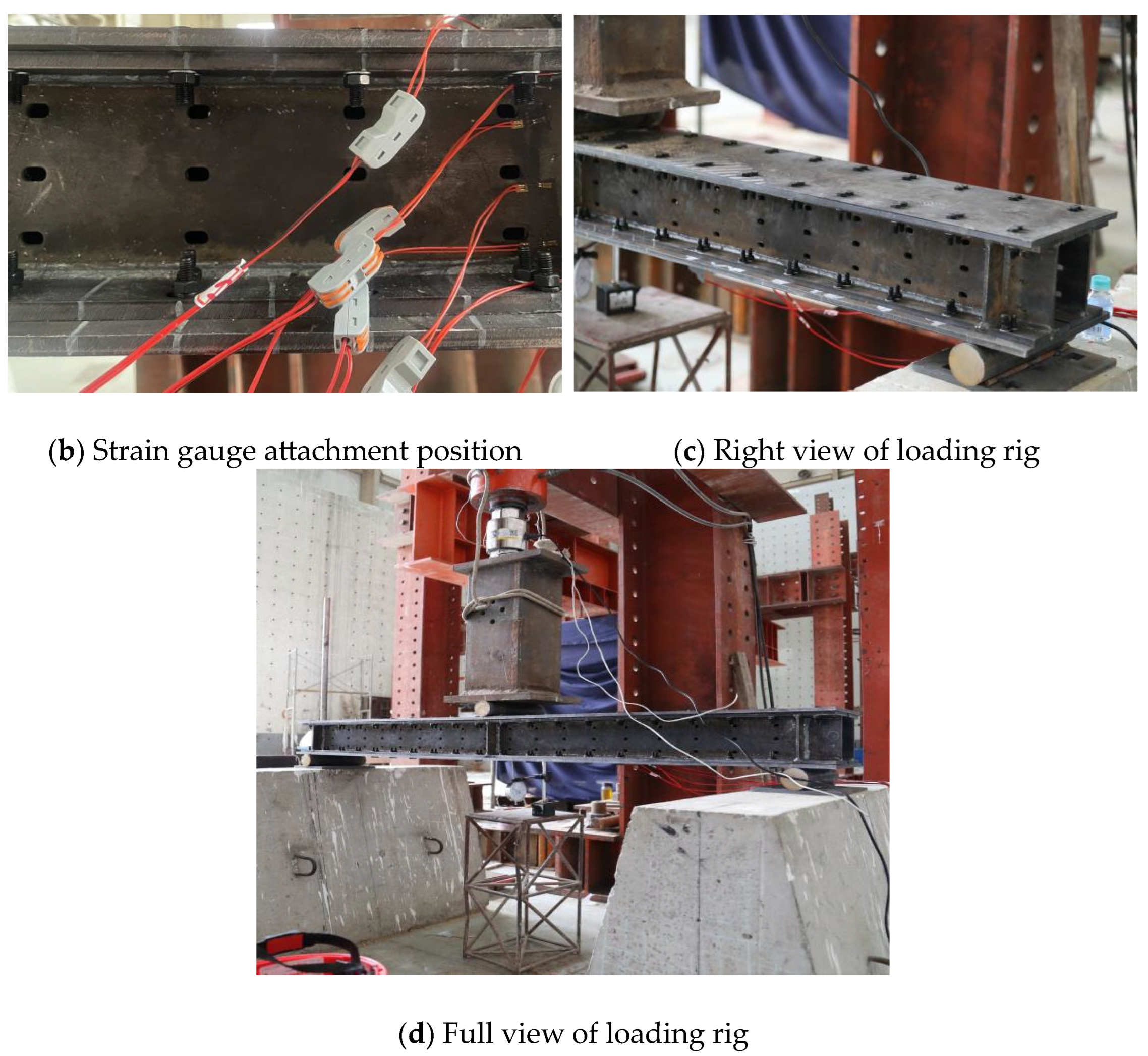
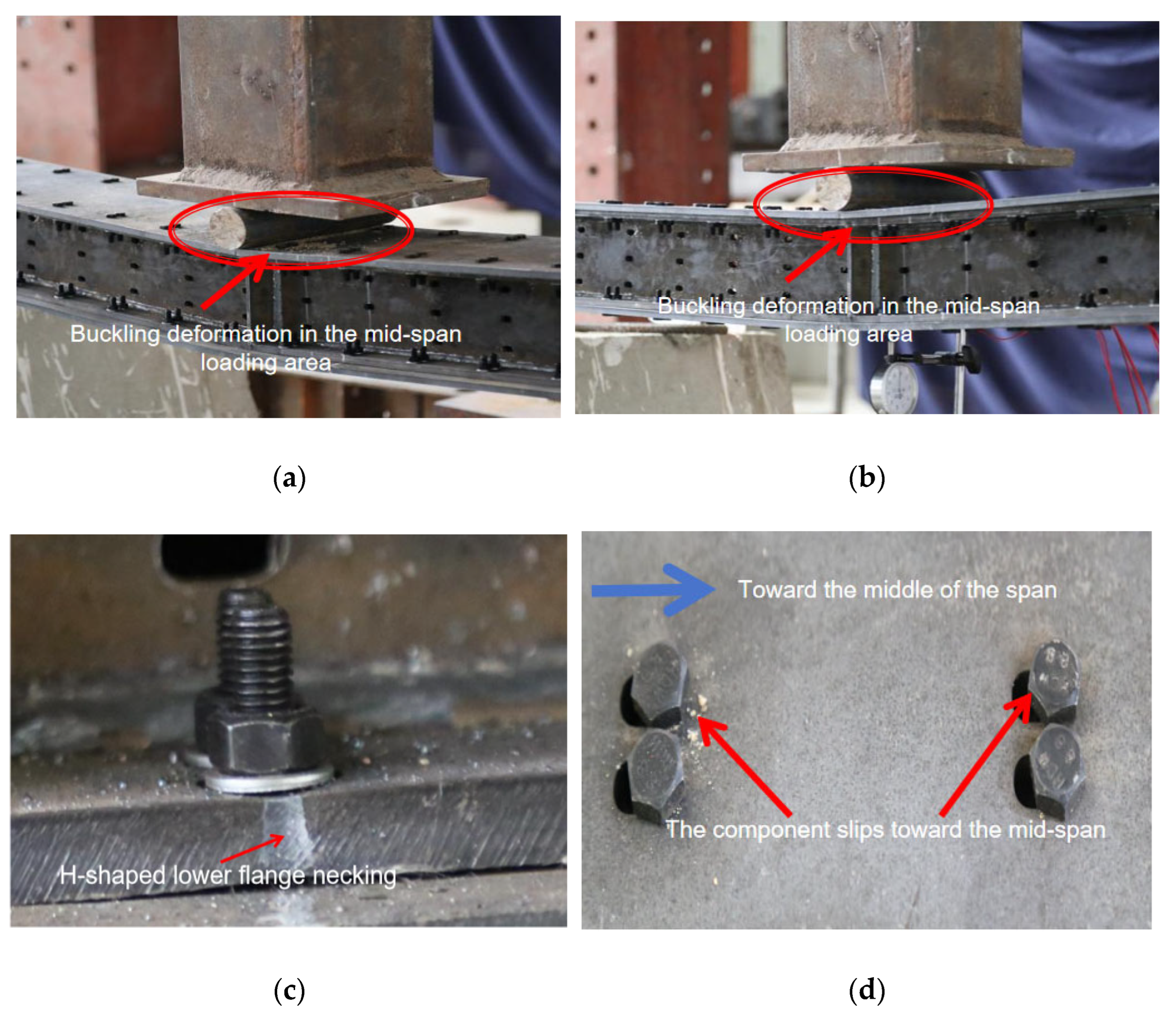



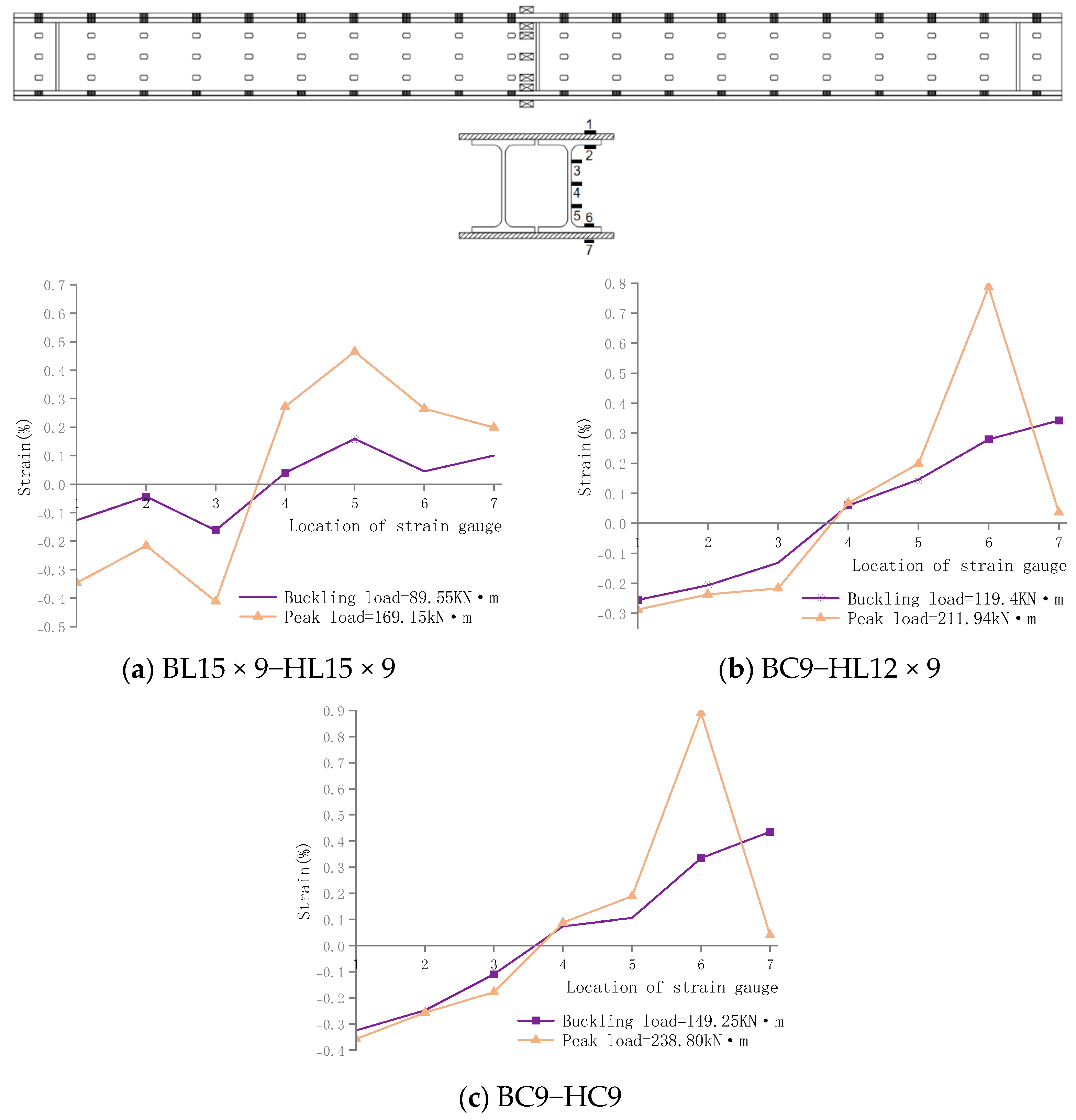
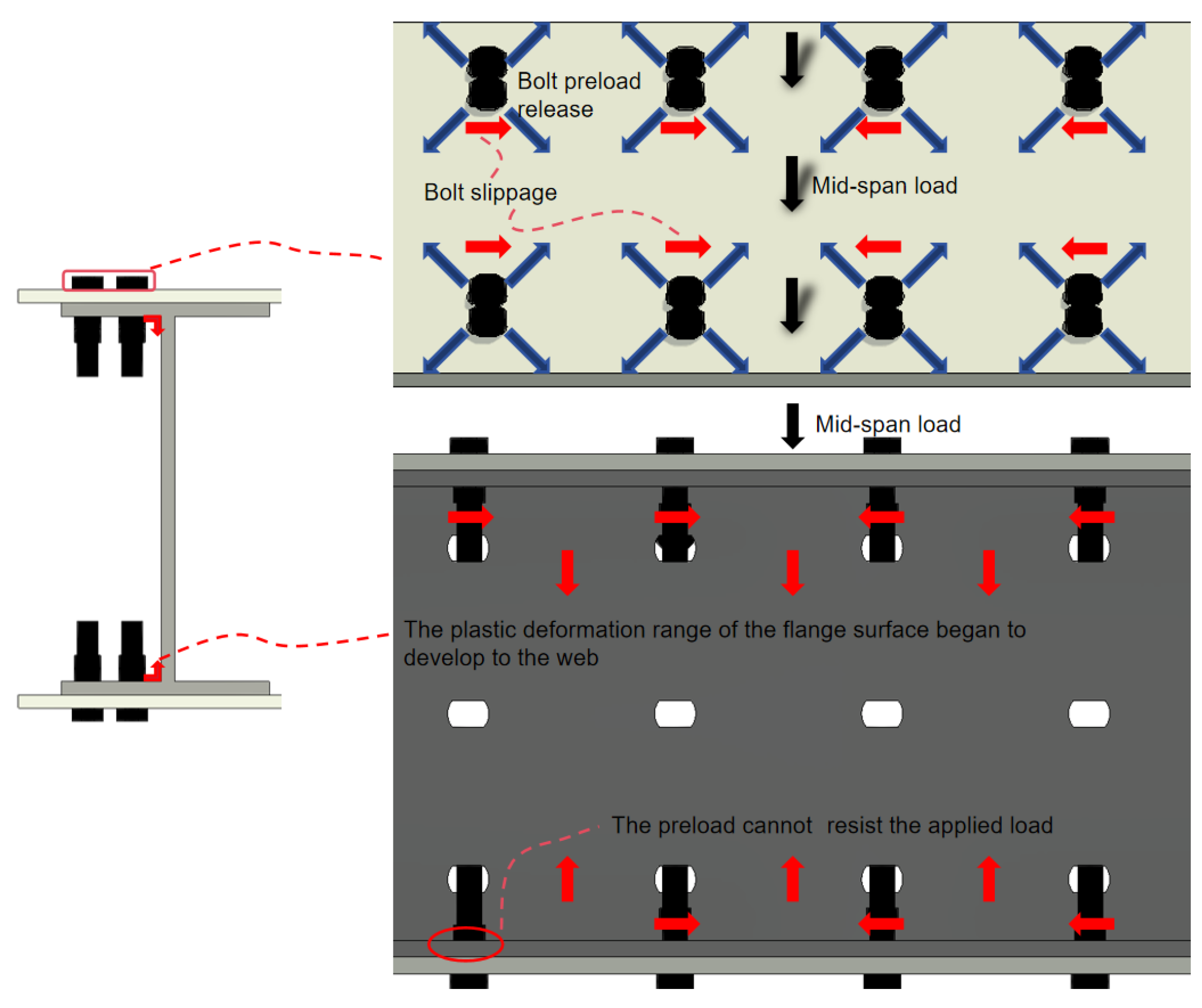
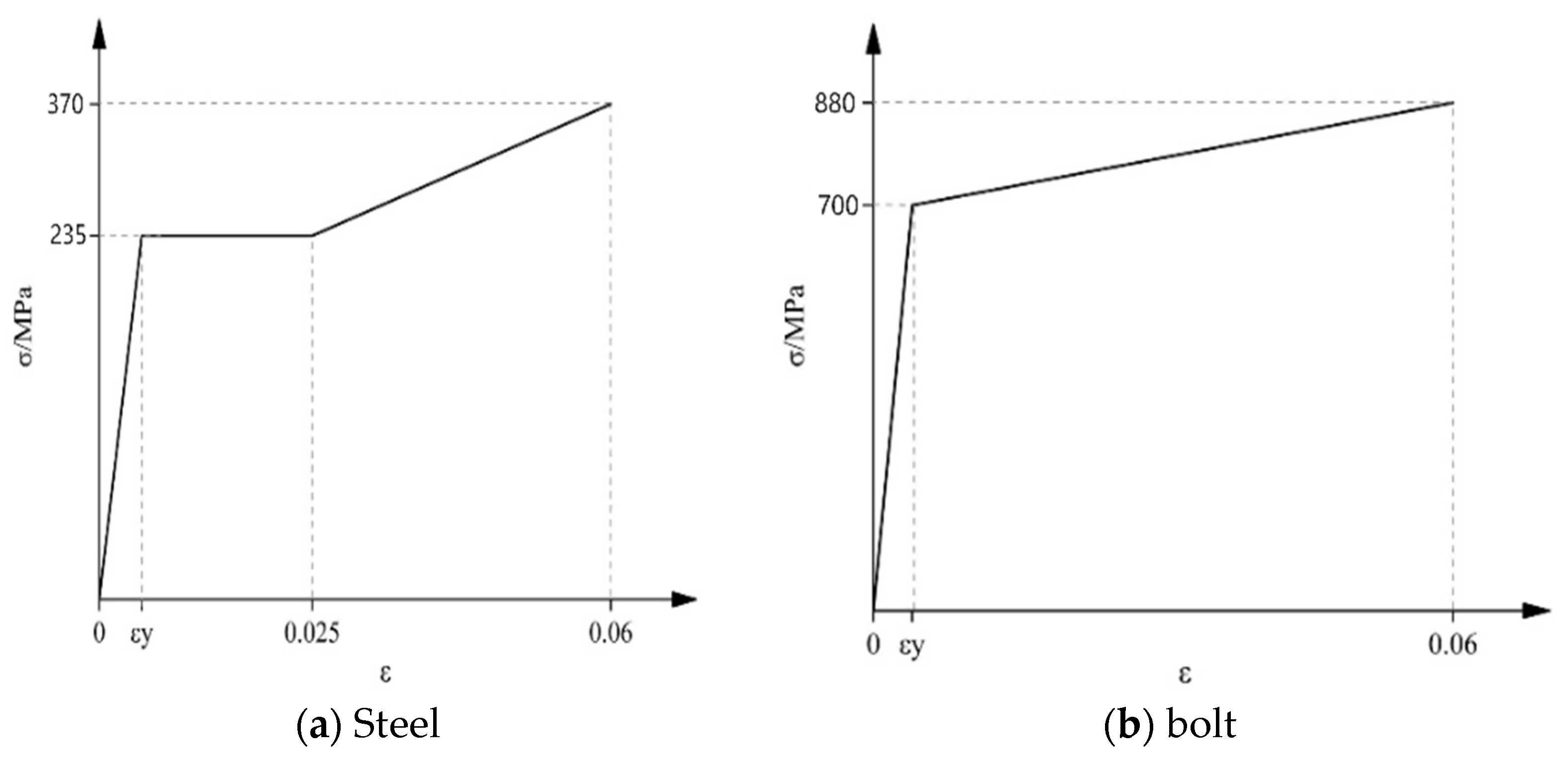
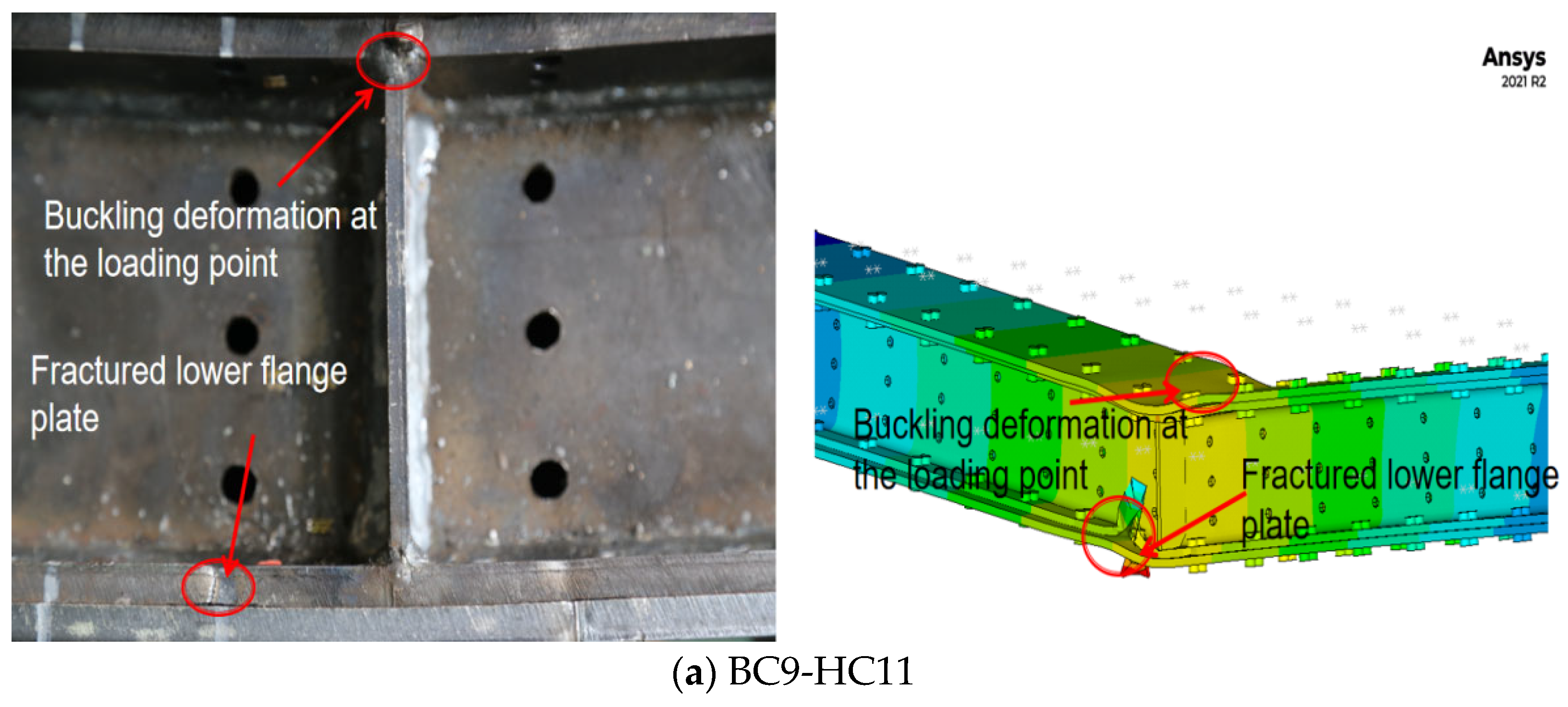



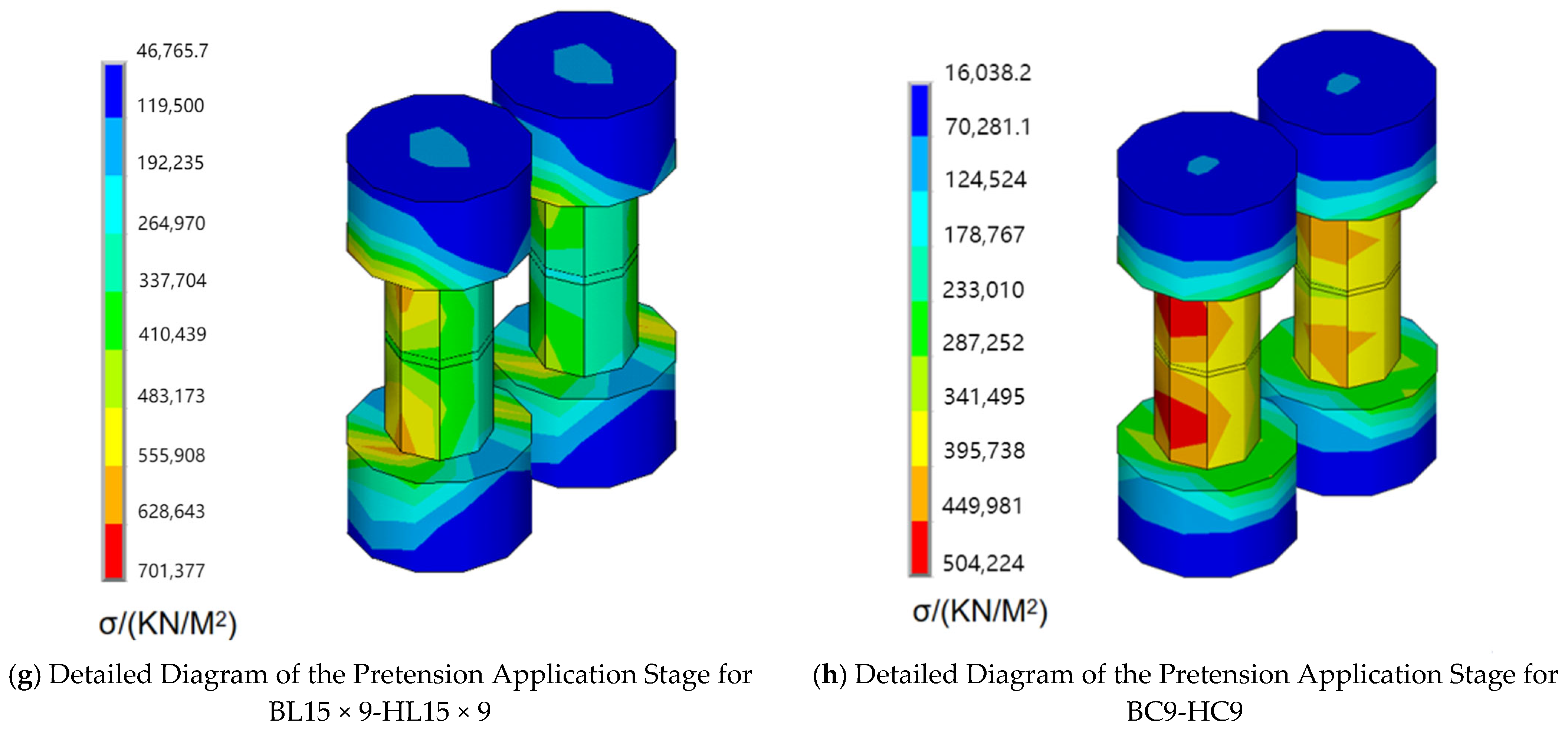
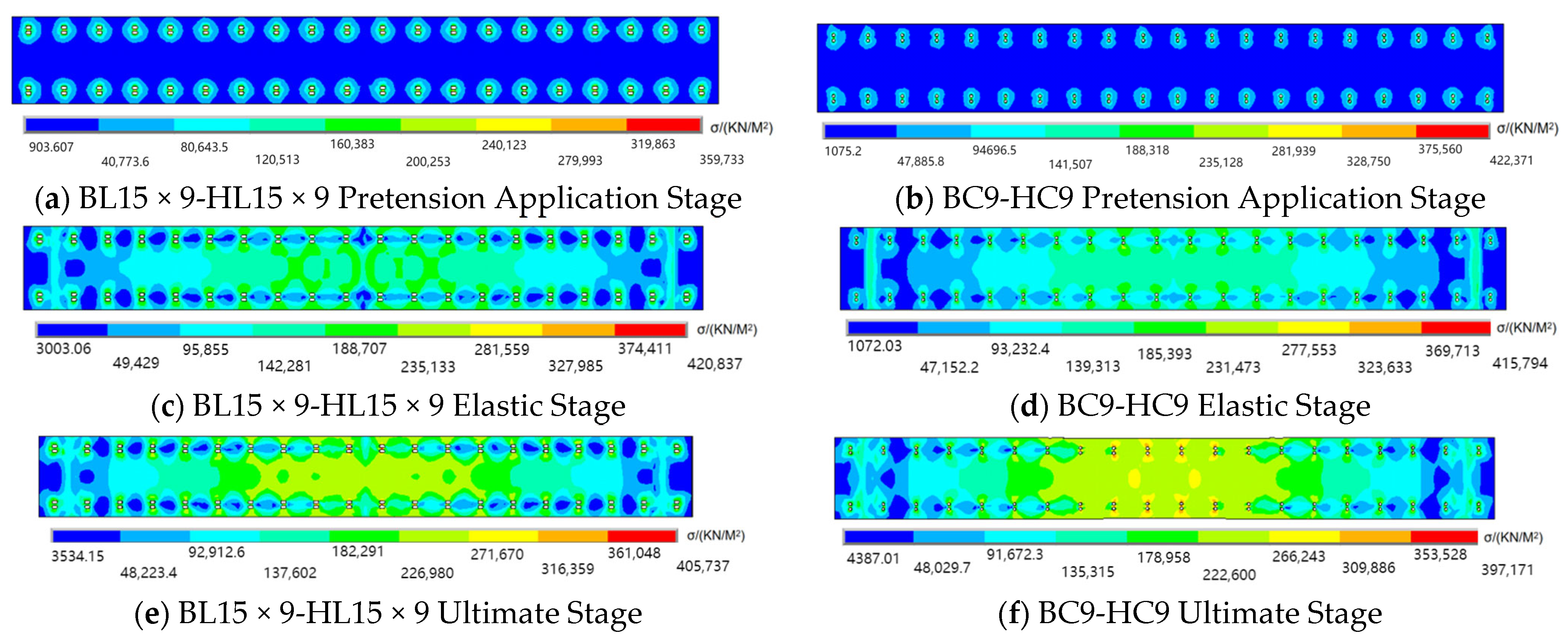
| Specimen Name | Bolt Hole Type of Connection Plate | Bolt Hole Type of HM150 Steel |
|---|---|---|
| BC9-HC9 | 9 mm Diameter Standard Circular Hole | 9 mm Diameter Standard Circular Hole |
| BC9-HC11 | 9 mm Diameter Standard Circular Hole | 11 mm Diameter Large Circular Hole |
| BC9-HL12 × 9 | 9 mm Diameter Standard Circular Hole | 9 mm × 12 mm Short Slot Hole |
| BC9-HL15 × 9 | 9 mm Diameter Standard Circular Hole | 9 mm × 15 mm Long Slot Hole |
| BL15 × 9-HL15 × 9 | 9 mm × 15 mm Long Slot Hole | 9 mm × 15 mm Long Slot Hole |
| Specimen ID | Sampling Location | Thickness /mm | Gauge Length (L0) /mm | Yield Strength /MPa | Ultimate Strength /MPa | Elastic Modulus /MPa | Elongation /% |
|---|---|---|---|---|---|---|---|
| H | H-shaped Steel | 9 | 100 | 260 | 390 | 255 | 20.2 |
| B | Connection Plate | 9 | 100 | 255 | 390 | 248 | 23.7 |
| L | Stiffening Rib | 6 | 80 | 245 | 430 | 256 | 19.6 |
| Specimen Name | Mp /(kN·m) | Reduction Factor of Ultimate Moment Capacity for the BC9-HC9 Component /% | Reduction Factor of Ultimate Moment Capacity for the BC9-HC9 Component /% | Failure Mode | Failure Stiffness /(kN·m2) |
|---|---|---|---|---|---|
| BC9-HC9 | 238.80 | -- | 78.12 | FF-B | 152,460 |
| BC9-HC11 | 199 | 16.67 | 76.5 | FF-B | 129,740 |
| BC9-HL12 × 9 | 211.94 | 11.25 | 77.35 | FF-B | 136,658 |
| BC9-HL15 × 9 | 175.12 | 26.67 | 65.43 | FF-L | 133,487 |
| BL15 × 9-HL15 × 9 | 169.15 | 29.17 | 46.31 | FF-L | 182,171 |
| Specimen Name | Bending Moment in the Elastic Phase /(kN·m) | The Maximum y-Direction Displacement Value of the Bending Moment in the Elastic Phase /mm | Flexural Stiffness /(kN·m2) |
|---|---|---|---|
| BC9-HC9 | 149.25 | 11.4 | 65,297 |
| BC9-HC11 | 119.4 | 10.64 | 56,180 |
| BC9-HL12 × 9 | 119.4 | 9.36 | 63,352 |
| BC9-HL15 × 9 | 89.55 | 5.70 | 78,356 |
| BL15 × 9-HL15 × 9 | 89.55 | 6.05 | 73,823 |
| Specimen | Test Results | ANSYS Results | Mp/Ma | ||
|---|---|---|---|---|---|
| Mp/(kN·m) | Failure Mode | Ma/(kN·m) | Failure Mode | ||
| BC9-HC9 | 238.80 | FF-B | 218.9 | FF-B | 1.091 |
| BC9-HC11 | 199 | FF-B | 199 | FF-B | 1.000 |
| BC9-HL12 × 9 | 211.94 | FF-B | 199 | FF-B | 1.065 |
| BC9-HL15 × 9 | 175.12 | FF-L | 169.15 | FF-L | 1.035 |
| BL15 × 9-HL15 × 9 | 169.15 | FF-L | 169.15 | FF-L | 1 |
| Mean | 1.038 | ||||
| St.Dev | 0.036 | ||||
| Specimen Name | Comparison of Deviations from the Respective Experimental Ultimate Moments /% | Reduction Factor of Ultimate Moment Capacity for the BC9-HC9 Component /% | Maximum y-Direction Displacement under Ultimate Moment Capacity /mm | Interpolation of the Maximum y-Direction Displacement for Each Respective Experiment /mm |
|---|---|---|---|---|
| BC9-HC9 | 8.3 | -- | 79.13 | +1.01 |
| BC9-HC11 | -- | 9.1 | 78.79 | −0.04 |
| BC9-HL12 × 9 | 6.1 | 9.1 | 79.01 | +2.29 |
| BC9-HL15 × 9 | 3.4 | 22.7 | 66.4 | +0.97 |
| BL15 × 9-HL15 × 9 | -- | 22.7 | 46.31 | +4.1 |
Disclaimer/Publisher’s Note: The statements, opinions and data contained in all publications are solely those of the individual author(s) and contributor(s) and not of MDPI and/or the editor(s). MDPI and/or the editor(s) disclaim responsibility for any injury to people or property resulting from any ideas, methods, instructions or products referred to in the content. |
© 2024 by the authors. Licensee MDPI, Basel, Switzerland. This article is an open access article distributed under the terms and conditions of the Creative Commons Attribution (CC BY) license (https://creativecommons.org/licenses/by/4.0/).
Share and Cite
Zhang, X.; Yu, S.; Feng, S.; Fan, D.; Zhang, F.; Cao, H. Study on the Bending Performance of Prefabricated H-Shaped Steel Beams with Different Bolt Hole Types. Buildings 2024, 14, 2988. https://doi.org/10.3390/buildings14092988
Zhang X, Yu S, Feng S, Fan D, Zhang F, Cao H. Study on the Bending Performance of Prefabricated H-Shaped Steel Beams with Different Bolt Hole Types. Buildings. 2024; 14(9):2988. https://doi.org/10.3390/buildings14092988
Chicago/Turabian StyleZhang, Xin, Shenlu Yu, Shuaike Feng, Dawei Fan, Fang Zhang, and Han Cao. 2024. "Study on the Bending Performance of Prefabricated H-Shaped Steel Beams with Different Bolt Hole Types" Buildings 14, no. 9: 2988. https://doi.org/10.3390/buildings14092988
APA StyleZhang, X., Yu, S., Feng, S., Fan, D., Zhang, F., & Cao, H. (2024). Study on the Bending Performance of Prefabricated H-Shaped Steel Beams with Different Bolt Hole Types. Buildings, 14(9), 2988. https://doi.org/10.3390/buildings14092988





